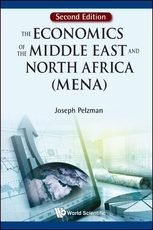
The Economics of the Middle East and North Africa (MENA): 2nd Edition
MENA, Middle East, North Africa, Arab Middle East, Israel in MENA, Economics and Arab Spring, Human Capital and Economic Growth, Economic Development, Labor Market Imperfections, Technology Gap within MENA, Financial Markets in MENA, Natural Borders within MENA and Intra- and Extra -MENA Region Trade, Economics of Corruption, Natural Resource Curse in MENA, Inequality of Opportunity in MENA, Intergenerational Mobility of Wealth, Gender Bias in Arab MENA, State Industrialization
Authors : Joseph Pelzman (George Washington University, USA)
Publisher : World Scientific
ISBN : 978-981-3203-97-6
There are currently no reviews for this book title.
The Middle East and North Africa (MENA) is a large, complex, and diverse region, which faces a wide range of economic issues. The MENA group includes Algeria, Bahrain, Cyprus, Djibouti, Egypt, Iran, Iraq, Israel, Jordan, Kuwait, Lebanon, Libya, Morocco, Oman, Qatar, Saudi Arabia, Syria, Tunisia, Turkey, United Arab Emirates, and Yemen.
The purpose of this book is not to provide a country-by-country study, but rather to deal with general economic themes found in Arab MENA and Israel, such as problems associated with growth and structural change; the role of State-intervention in country-specific local markets; labor market imperfections driven by gender bias; technology gaps and endogenous growth; capital market development in a restricted financial model based on religious constraints; savings and investment behaviour in a model of state subsidization and intervention designed to control local development; and the role of the state in constraining private sector activity. Data sources used in this second edition include country-specific data, the World Bank, the United Nations, the International Monetary Fund and the Organisation for Economic Co-operation and Development.
The new material in this second edition includes a discussion of the impending and inevitable leadership changes which will occur throughout Arab MENA over the next decades. The evidence to support this evaluation is based on the current lack of transparent markets; the lack of inclusive macro policies, the impact of distortionary micro economic policies across all sectors; and the impact of anti-globalization and xenophobia on innovation. Old chapters are revised with updated data, a discussion of the role of the "State" and "Oligarchies" in the economies of most of the MENA countries, an in-depth exploration of the investment in human capital and growth and an identification of the most important binding constraints to economic development in Arab MENA and Israel.
This book serves as both a textbook and a summary of the very large literature on MENA. It examines the economic realities of the region and compares them across the MENA economies. It should be stressed that this book is not about the latest political debate on who did what to whom in the Middle East or in North Africa. The focus is on economics, not political economics.
The purpose of this book is not to provide a country-by-country study, but rather to deal with general economic themes found in Arab MENA and Israel, such as problems associated with growth and structural change; the role of State-intervention in country-specific local markets; labor market imperfections driven by gender bias; technology gaps and endogenous growth; capital market development in a restricted financial model based on religious constraints; savings and investment behaviour in a model of state subsidization and intervention designed to control local development; and the role of the state in constraining private sector activity. Data sources used in this second edition include country-specific data, the World Bank, the United Nations, the International Monetary Fund and the Organisation for Economic Co-operation and Development.
The new material in this second edition includes a discussion of the impending and inevitable leadership changes which will occur throughout Arab MENA over the next decades. The evidence to support this evaluation is based on the current lack of transparent markets; the lack of inclusive macro policies, the impact of distortionary micro economic policies across all sectors; and the impact of anti-globalization and xenophobia on innovation. Old chapters are revised with updated data, a discussion of the role of the "State" and "Oligarchies" in the economies of most of the MENA countries, an in-depth exploration of the investment in human capital and growth and an identification of the most important binding constraints to economic development in Arab MENA and Israel.
This book serves as both a textbook and a summary of the very large literature on MENA. It examines the economic realities of the region and compares them across the MENA economies. It should be stressed that this book is not about the latest political debate on who did what to whom in the Middle East or in North Africa. The focus is on economics, not political economics.
Details for these authors are currently not available.
There are currently no reviews for this book title.
Buy this book, https://www.worldscientific.com/worldscibooks/10.1142/10352, 13575, false
FAQs
Click on the "Buy this book" button
You can email us at book-review@enago.com and we will get back to you with the next steps shortly.
New Releases
-

Advances in the Molecular Understanding of Colorectal Cancer
-

Basic Research and Industrial Innovation in China
-

Constable & Lim Colour Atlas Of Ophthalmology: Sixth Edition
-

Essentials of Ophthalmology: For Medical School and Beyond
-

Fixed Revenue Accounting: A New Management Accounting Framework
All featured publishers and authors can avail of a free promotional interview on Enago Academy! Write to us now!
